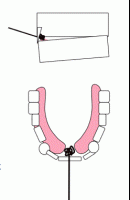
Q: My preschool client with apraxia can only say “K” when he bobs his head around. Should I ignore this as part of the learning process? Some clients seem to need extraneous movement to initiate a phoneme’s movements, but they do not need them for long. I see them as gross movements that will become more refined with time. I usually let my clients do all this extra movement at first, and I even emphasize it by imitating it back…


